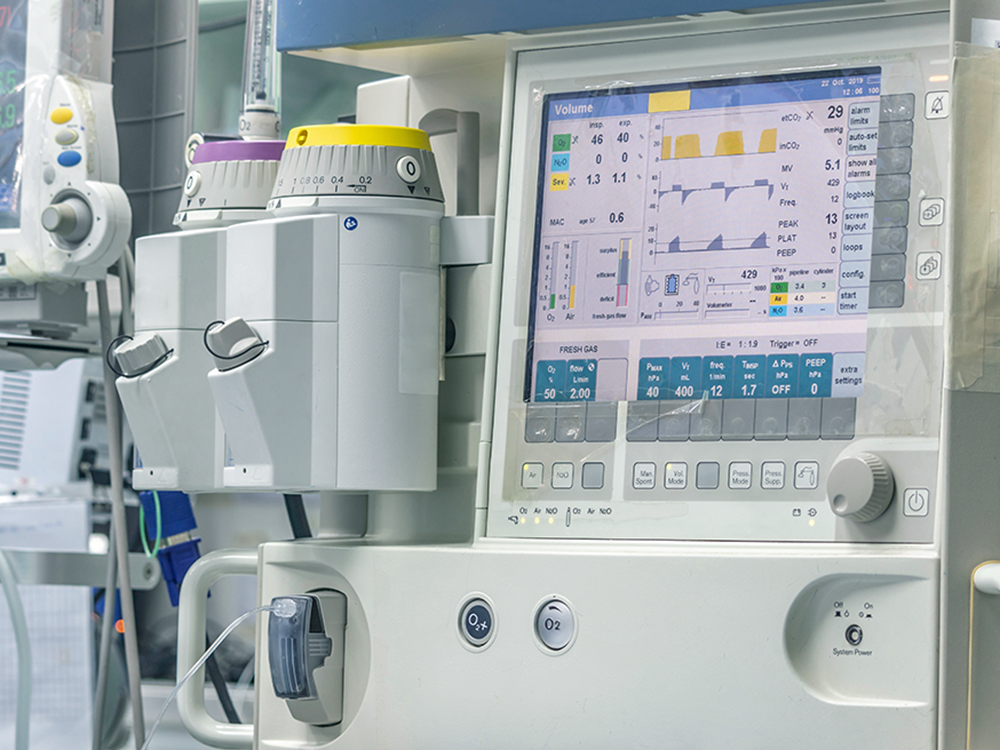How to Choose the Right Anesthesia Machine for Your Practice
April 1, 2025

Even though anesthesia machines provide essentially the same function in any operating room or procedure suite, no machine is one size fits all. Before purchasing an anesthesia machine for your practice, you need to find answers for these basic questions:
- What kind of anesthesia machine do you need?
- Does a refurbished anesthesia machine make sense for your facility?
- Is your new anesthesia machine compatible with my other operating room equipment?
- Is this anesthesia machine a good investment for your facility?
What Kind of Anesthesia Machine Do You Need?
The easiest way to approach this question is asking yourself, “Do I need an anesthesia ventilator?” Ventilators are necessary for all procedures requiring general anesthesia where the patient requires deeper sedation. If your facility performs these kinds of procedures, you’ll be needing an integrated anesthesia system.
Integrated Systems
Integrated anesthesia systems are designed for full operating rooms with heavy surgical schedules. Integrated units usually offer ventilation with volume and pressure control and other advanced modes. They also typically feature three vaporizer chambers, integrated monitoring, gas delivery management, and they are compatible with electronic data systems.
Portable Systems
If you don’t require an anesthesia ventilator, a table top or portable anesthesia system is a good option. Portable anesthesia systems are designed for field work or office-based procedures that require conscious sedation. Portable anesthesia machines are used especially often in monitored anesthesia care (MAC), where a clinician delivers local anesthesia together with sedation and analgesia.
Does a Refurbished Machine Make Sense for Your Facility?
Purchasing a refurbished anesthesia machine can certainly help your bottom line, but cost isn’t the only benefit. A refurbished unit can also save valuable time at your facility that would otherwise be spent training your staff on the latest technology of your factory new unit.
The benefits of refurbished equipment need to be considered with the caveat that a reconditioned anesthesia machine is only as good as the company who completes the refurbishing process. To be sure you’re choosing a reputable refurbishing company, make sure that they have the necessary experience, inventory, and refurbishment process to guarantee a quality product.
Are Your Other Systems Compatible?
Unless your anesthesia machine purchase is part of a complete equipment overhaul in your facility, it’s a good idea to determine how your new unit will function with your existing equipment.
Check to see the vaporizer mounting options for your new anesthesia machine, and whether you’ll need to purchase new vaporizers that are compatible. This is especially important if you plan to switch anesthesia machine brands.
If you’re currently using mounting tracks to position exam lights or monitors, be sure that the mounting options on your new machine are consistent. You’ll also need to evaluate your current scavenging system and gas delivery system.
Is this Anesthesia Machine a Good Investment?
Determining the true value of your new anesthesia machine involves factoring in a few important factors. Consider the initial price of purchase along with the expected maintenance costs to make sure your facility is prepared to cover those expenses.
It also helps to be prepared for equipment problems that occur outside of the realm of routine maintenance. Ask yourself, “what’s the most expensive thing that could go wrong?”
End-of-life Considerations
Determining the eventual “End of Life” for an anesthesia machine is important — especially when comparing refurbished models. Despite the finite-sounding name, EOL simply refers to the time set by the original equipment manufacturer after which they will no longer provide support.
Anesthesia machines can function for years after their EOL dates with the help of qualified, third-party maintenance services. If your machine is nearing its EOL, be sure to find a trusted maintenance provider with access to quality new or used parts and experience in servicing your specific model.
Additional Factors
Do you need an MRI-compatible anesthesia machine?
In situations where the anesthesia machine will be in close proximity to an MRI machine or another imaging system, a MRI-compatible anesthesia machine is necessary. MRI-compatible anesthesia machines are constructed using non-ferrous materials including carbon fiber, plastic, and other metals low in iron. MRI-compatible machines also shield any electronic elements that could be damaged by magnetic resonance in an imaging suite.
Brand-specific anesthesia machine features
If you’re in the market for a new anesthesia machine, take the time to compare and contrast anesthesia machine brands. Anesthesia brands often have unique proprietary features which might work well with your practice. For example, Dräger has established itself as the top manufacturer of piston-driven anesthesia ventilators. Piston ventilators don’t require drive gas, and are intended to be more precise than traditional bellows-driven technology.